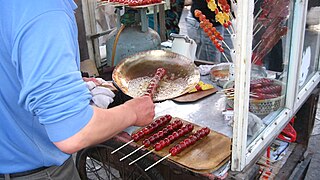
Midwestern cuisine is a regional cuisine of the American Midwest. It draws its culinary roots most significantly from the cuisines of Central, Northern and Eastern Europe, and Indigenous cuisine of the Americas, and is influenced by regionally and locally grown foodstuffs and cultural diversity.

A hamburger, or simply burger, is a food consisting of fillings—usually a patty of ground meat, typically beef—placed inside a sliced bun or bread roll. Hamburgers are often served with cheese, lettuce, tomato, onion, pickles, bacon, or chilis; condiments such as ketchup, mustard, mayonnaise, relish, or a "special sauce", often a variation of Thousand Island dressing; and are frequently placed on sesame seed buns. A hamburger patty topped with cheese is called a cheeseburger.

The horseshoe is an open-faced sandwich originating in Springfield, Illinois, United States. It consists of thick-sliced toasted bread, a hamburger patty or other choice of meat, French fries, and cheese sauce.

Egg foo young is an omelette dish found in Chinese Indonesian, British Chinese, and Chinese American cuisine. The name comes from the Cantonese language. Egg foo young is derived from fu yung egg slices, a mainland Chinese recipe from Guangdong.

Imo's Pizza is an American chain of pizza restaurants headquartered in St. Louis, Missouri. As of 2020, the company says it has more than 100 restaurants and stores in Missouri, Illinois and Kansas.

Singaporean cuisine is derived from several ethnic groups in Singapore and has developed through centuries of political, economic, and social changes in the cosmopolitan city-state.

The St. Paul sandwich can be found in many Chinese American restaurants in St. Louis, Missouri, as well as in other cities in Missouri, including Columbia, Jefferson City, and Springfield. The sandwich consists of an egg foo young patty served with dill pickle slices, white onion, mayonnaise, and lettuce between two slices of white bread. The St. Paul sandwich also comes in different combinations and specials, such as chicken, pork, shrimp, beef, and other varieties.

A slinger is an American Midwest diner specialty typically consisting of two eggs, hash browns, and a ground beef patty, all covered in chili con carne and generously topped with cheese and onions. The eggs can be any style. Hot sauce is usually served on the side. The slinger is considered to be a St. Louis late-night culinary original. It is described as "a hometown culinary invention: a mishmash of meat, hash-fried potatoes, eggs, and chili, sided with your choice of ham, sausage, bacon, hamburger patties, or an entire T-bone steak.

The cuisine of New Jersey is derived from the state's long immigrant history and its close proximity to both New York City and Philadelphia. Due to its geographical location, New Jersey can generally be divided by New York City cuisine in the northern and central parts of the state and Philadelphia cuisine in the southern parts. Restaurants in the state often make use of locally grown ingredients such as asparagus, blueberries, cranberries, tomatoes, corn, and peaches. New Jersey is particularly known for its diners, of which there are approximately 525, the most of any state. Various foods invented in the state, such as the pork roll, and salt water taffy, remain popular there today.

Uruguayan cuisine is a fusion of cuisines from several European countries, especially of Mediterranean foods from Spain, Italy, Portugal and France. Other influences on the cuisine resulted from immigration from countries such as Germany and Scotland. Uruguayan gastronomy is a result of immigration, rather than local Amerindian cuisine, because of late-19th and early 20th century immigration waves of, mostly, Italians. Spanish influences are abundant: desserts like churros, flan, ensaimadas yoo (Catalan sweet bread), and alfajores were all brought from Spain. There are also all kinds of stews known as guisos or estofados, arroces, and fabada. All of the guisos and traditional pucheros (stews) are also of Spanish origin. Uruguayan preparations of fish, such as dried salt cod (bacalao), calamari, and octopus, originate from the Basque and Galician regions, and also Portugal. Due to its strong Italian tradition, all of the famous Italian pasta dishes are present in Uruguay including ravioli, lasagne, tortellini, fettuccine, and the traditional gnocchi. Although the pasta can be served with many sauces, there is one special sauce that was created by Uruguayans. Caruso sauce is a pasta sauce made from double cream, meat, onions, ham and mushrooms. It is very popular with sorrentinos and agnolotti. Additionally, there is Germanic influence in Uruguayan cuisine as well, particularly in sweet dishes. The pastries known as bizcochos are Germanic in origin: croissants, known as medialunas, are the most popular of these, and can be found in two varieties: butter- and lard-based. Also German in origin are the Berlinese known as bolas de fraile, and the rolls called piononos. The facturas were re-christened with local names given the difficult German phonology, and usually Uruguayanized by the addition of a dulce de leche filling. Even dishes like chucrut (sauerkraut) have also made it into mainstream Uruguayan dishes.
The cuisine of Minnesota is a type of Midwestern cuisine found throughout the state of Minnesota in the United States of America.
A hamburger is a sandwich that consists of a cooked ground meat patty, usually beef, placed between halves of a sliced bun. Hamburgers are often served with various condiments, such as dill relish (condiment), mayonnaise, and other options including lettuce, tomato, onion, pickles, and cheese.

A meatball is ground meat (mince) rolled into a ball, sometimes along with other ingredients, such as bread crumbs, minced onion, eggs, butter, and seasoning. Meatballs are cooked by frying, baking, steaming, or braising in sauce. There are many types of meatballs using different types of meats and spices. The term is sometimes extended to meatless versions based on vegetables or fish; the latter are also commonly known as fish balls.

Regional street food is street food that has commonalities within a region or culture.

Breaded cutlet or braised cutlet is a dish made from coating a cutlet of meat with breading or batter and either frying or baking it.
















